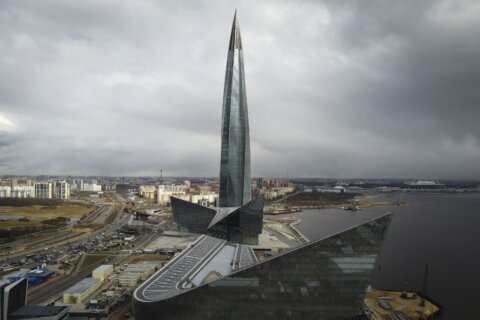Ukrainian sea drones reportedly sank another Russian warship in the Black Sea on Tuesday, the latest in a series of strikes that has crippled Moscow’s naval capability and limited its operations with the war now in its third year.
Successful Ukrainian drone and missile strikes have provided a major morale boost for Kyiv at a time when its undermanned and under-gunned forces are facing Russian attacks along the more than 1,000-kilometer (600-mile) front line.
Challenging Russia’s naval superiority also has helped create more favorable conditions for Ukrainian grain exports and other shipments from the country’s Black Sea ports.
Here’s a look at recent Ukrainian attacks against Russian naval assets and their consequences.
RELENTLESS STRIKES
In the latest reported strike, Ukrainian naval drones attacked the Sergei Kotov patrol ship near the Kerch Strait, which links the Black Sea and the Sea of Azov, according to the Ukraine’s military intelligence agency. The strike, which couldn’t be independently verified, killed seven members of the Russian crew and injured six others, while 52 were rescued, the agency said.
The Russian Defense Ministry didn’t comment on the claim, but some Russian military bloggers confirmed the ship’s loss and said its crew had been rescued.
The strike, if verified, would mark the latest successful use of Ukraine’s domestically produced Magura drones, the agile uncrewed boats that have become the Russian navy’s nemesis. Just last month, drones sank Russia’s Caesar Kunikov amphibious landing ship and Ivanovets missile corvette. The Russian military hasn’t acknowledged those losses, either, but they have been reported by Russian military bloggers and some media.
In another attack in late December, Ukraine said it destroyed the Novocherkassk landing vessel in Crimea’s port of Feodosia with long-range cruise missiles. The Russian Defense Ministry said the ship was damaged in the attack, but Russian war bloggers said it was lost.
The Ukrainian military also has launched a series of persistent cruise missile and drone strikes on Russian radar facilities, air defense assets and air bases in Crimea, a region of Ukraine that Russia annexed in 2014. Increasing the pain for Moscow, Ukrainian troops also downed two Russian early warning and control aircraft over the Sea of Azov in January and February, depriving the Russian military of some of its most precious intelligence-gathering assets.
The strikes followed other highly efficient Ukrainian attacks earlier in the war, including the April 2022 sinking of the Black Sea fleet’s flagship missile cruiser, the Moskva, and a missile strike last September on the fleet’s headquarters in the port of Sevastopol.
UKRAINE’S DEADLY WEAPONS
The smart use of remote-controlled drone boats laden with explosives has allowed Ukraine to tip the scales of naval warfare in its favor despite Russia’s massive superiority in firepower. The Magura drones are equipped with advanced GPS and cameras, and have a low radar signature that makes them hard to detect.
Its latest version, the Magura V5, is 5.5 meters (18 feet) long, weighs up to 1,000 kilograms (2,200 pounds) and has a range of up to 800 kilometers (500 miles), 60 hours of battery life, and a 200-kilogram (440-pound) payload, according to Ukrainian authorities. It also beams live video to operators.
Ukraine also has relied on cruise missiles provided by the U.K. and France for striking Russian assets in Crimea. The missiles — produced jointly by Britain and France and called Storm Shadow by the U.K. and SCALP-EG by France — are launched from Ukraine’s Soviet-era warplanes and have a range of more than 250 kilometers (155 miles).
Western officials praise the efficiency of the Ukrainian attacks, noting that Kyiv has smartly used its limited resources to defeat far stronger Russian forces and destroy about 20% of the Black Sea fleet, effectively blunting Moscow’s naval dominance.
ENDING THE RUSSIAN BLOCKADE
The successful strikes on Russian naval assets have allowed Ukraine to increase its food and other Black Sea exports despite Russia’s withdrawal last summer from a deal that guaranteed safe shipment of Ukrainian grain.
Moscow’s pullback from the deal raised the possibility of Russian attacks on ships carrying Ukrainian grain and other products, posing a threat to the Ukrainian economy and global food security.
But the steady series of successful Ukrainian attacks on Russian warships and other military assets in the area have put Russia’s fleet on the defensive, limiting its offensive capability.
HOW DID RUSSIA REACT?
Although the Russian Defense Ministry has mostly kept quiet about the Ukrainian drone and missile attacks on its naval assets, Russian military bloggers and commentators have harshly criticized the military brass for its slow and sloppy response to the threat.
The strikes have forced the Russian navy to take precautions that have affected its operations, including relocating some of its ships from ports in Crimea farther east to Novorossiysk to better protect them.
Despite the damage from Ukrainian attacks, the Black Sea fleet remains a powerful force and is still capable of launching long-range cruise missile strikes at Ukraine. Russian air bases in Crimea also have remained operational, hosting warplanes that have continued flying combat sorties to support its ground operations in the region.
Russian military bloggers reported that the head of the Black Sea fleet, Adm. Viktor Sokolov, was dismissed last month following the latest losses of warships. There was no official confirmation of his ouster.
___
Find more AP coverage at https://apnews.com/hub/russia-ukraine
Copyright © 2025 The Associated Press. All rights reserved. This material may not be published, broadcast, written or redistributed.







